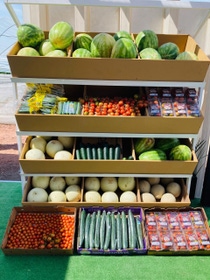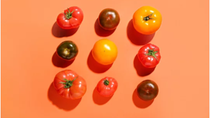Patents fuel new varieties
that farmers need for

Agriculture
For most people, a sophisticated machine sketch or a tricky chemical process design comes to mind when thinking about patents. But patents span many different industries and can even be granted for plants. Like your phone or your car, plant varieties are the result of many years of research and investment that are protected by legal rights like patents.
To Ena Hartig, patents are more than legal documents or rights. “Patents protect the work and investment that has gone into breeding and are an important motivation for any company to invest in research,” she explains. Ena oversees Research and Development for BASF’s vegetable seeds business, which develops new varieties of onions, tomatoes, and watermelons to name a few.
These aren’t ordinary vegetables. Her team develops plant-based inventions that address major trends emerging in society: think climate crisis, food waste, or food security.
Without patents, we would not have seen many of the greatest innovations that have answered mankind’s major challenges.
Breeders at BASF’s vegetable seeds business develop traits that allow a plant to cope with climate change or reduce food waste, for example by extending the shelf-life of vegetables. They breed new vegetable varieties that are resistant to certain diseases or can better withstand stresses that reduce farmers’ yields - which would eventually threaten the sufficient supply of healthy and affordable food for our growing population.
Patents are not granted for wild, naturally occurring flowers or trees that you admire during a summer stroll. Patents are granted for a breakthrough result that has never existed before thanks to years of intentional and careful plant breeding.
With a patent, the inventing party can manage the use of their invention, for example preventing its use by others or permitting contracted use. If other companies could immediately copy the invention and offer their own products based on it, this would significantly bring down the return for future investments by the innovative company. And there are limits to patent protections: they expire after a certain period of time, usually after 20 years.
“When we file for patent protection, we have to disclose the invention in such a way that it can be repeated by others,” explains Maurice Vroemen, a patent attorney with BASF’s vegetable seeds business.
“Patents stimulate scientific progress by allowing others to learn from the invention so that it can be improved, or alternatives developed, instead of reinventing the wheel,” points out Maurice. In this case, further research progress on the topic in question can be carried out by other companies, universities, or research institutions. “Patents provide that incentive to publish the invention rather than keep it secret.”
Patenting provides an incentive to publish the invention rather than keep it secret.
In addition, companies can grant licenses to allow other industry players to work with their patented inventions. Maurice says: “We license out many of the traits that we have developed to other seed companies. This leads to more progress and faster development of novel varieties that farmers and consumers want and need.”
Find out more in our FAQ section about how patented seed innovations are made available for use by others, for example through the International Licensing Platform (ILP) Vegetable and the Agricultural Crops Licensing Platform (ACLP).
Apart from patented plant features that benefit farmers and make agriculture more resilient and sustainable, plant innovations also appeal to consumers, such as seedless watermelons, tastier tomatoes, or even a tearless onion.
The origin story of the tearless onion starts in the 1980s when people were preparing more and more dishes that featured fresh onions. In-season onions were enjoyed for their mild flavor, however, when stored during the winter, onions become more pungent and less appealing to serve fresh. The idea was to create an onion that remained mild during those winter storage months.
After decades of breeding efforts, the team succeeded in creating a variety that was not only mild and sweet but had another benefit: no tears!
Published December 11, 2023 by Katie Lelito and Kaya Schmitz (BASF Agricultural Solutions)
For media inquiries or to repurpose the story, please contact:
Julian Prade


